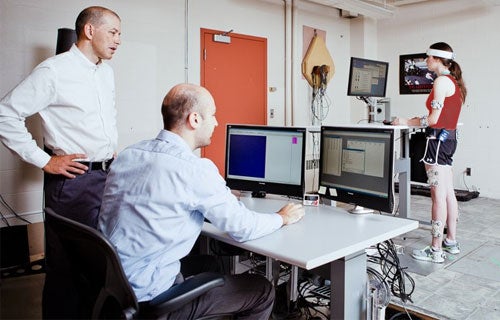
How long should you stand — rather than sit — at your work station?
A Waterloo researcher has found that you have to stand for at least 30 minutes every hour to get health benefits

A Waterloo researcher has found that you have to stand for at least 30 minutes every hour to get health benefits
By Christine Bezruki Faculty of Applied Health SciencesSitting behind your desk all day is bad for your health and experts have long been advising people to stand at their workstations for about 15 minutes an hour. But a University of Waterloo professor says his research shows that people should be standing for at least 30 minutes per hour to get health benefits.
Using advanced ergonomic and health risk calculations, Jack Callaghan, a professor in Waterloo’s Department of Kinesiology, has found that the ideal sit-stand ratio lies somewhere between 1:1 and 1:3 – a vast departure from traditional wisdom.
“Historically what has been preached is a three to one ratio, but we found the opposite will give you the benefits of not sitting as much, but not inducing problems from standing.” For an eight hour work day, the highest ratio works out to standing for a full 45 minutes every hour.
It’s all about striking the right balance according to Callaghan, a Canada Research Chair in Spine Biomechanics and Injury Prevention. In the first ever laboratory-controlled study of sit-stand workstations, Callaghan found that 50 per cent of participants developed low back pain when asked to stand at an ergonomic desk for two consecutive hours. None of the participants were previous back pain sufferers.

Kinesiology Professor Jack Callaghan (left) conducts study on optimal ratio for sitting versus standing at work
“Sitting has been demonized in the media, so people’s gut reaction is to try and stand all the time instead,” said Callaghan, who helped developed a new sit-stand workstation with the ergonomic furniture company, Teknion, last year. “There is no question a sedentary lifestyle negatively impacts health, but you can’t just all of a sudden take away people’s chairs, because it’s going to cause pain. And it’s not pain that will go away.”
Study participants who developed back pain while standing were three times more likely to experience chronic back problems later.
According to Callaghan, the key to avoiding back pain while still reaping the benefits of standing, is to move early and move often.
“It’s the same concept as dehydration during exercise,” he says. “If you wait until you’re thirsty it’s too late. If you wait until you have pain before you change positions, it’s too late. This pain is hard to get rid of, so you have to be moving and changing positions before it starts.”
Although standing-induced back pain is difficult to remedy once triggered, study participants who performed certain core exercises reported a significant decrease in pain.
Callaghan suggests some of the best core exercises to help reduce low back pain from standing include:
“I think it’s important to stand,” says Callaghan. “Even if the health risks of sitting are exaggerated in the media, the health risks associated with sitting are sobering and the mentality of sitting being bad is out there. Workers want to change, companies want to change, so something has to be done.”

Read more
Here are the people and events behind some of this year’s most compelling Waterloo stories

Read more
Researchers awarded funding to investigate ecology, climate change, repatriation, health and well-being through cultural and historical lens

Read more
Meet five exceptional Waterloo graduate students crossing the convocation stage as Class of 2025 valedictorians
The University of Waterloo acknowledges that much of our work takes place on the traditional territory of the Neutral, Anishinaabeg, and Haudenosaunee peoples. Our main campus is situated on the Haldimand Tract, the land granted to the Six Nations that includes six miles on each side of the Grand River. Our active work toward reconciliation takes place across our campuses through research, learning, teaching, and community building, and is co-ordinated within the Office of Indigenous Relations.